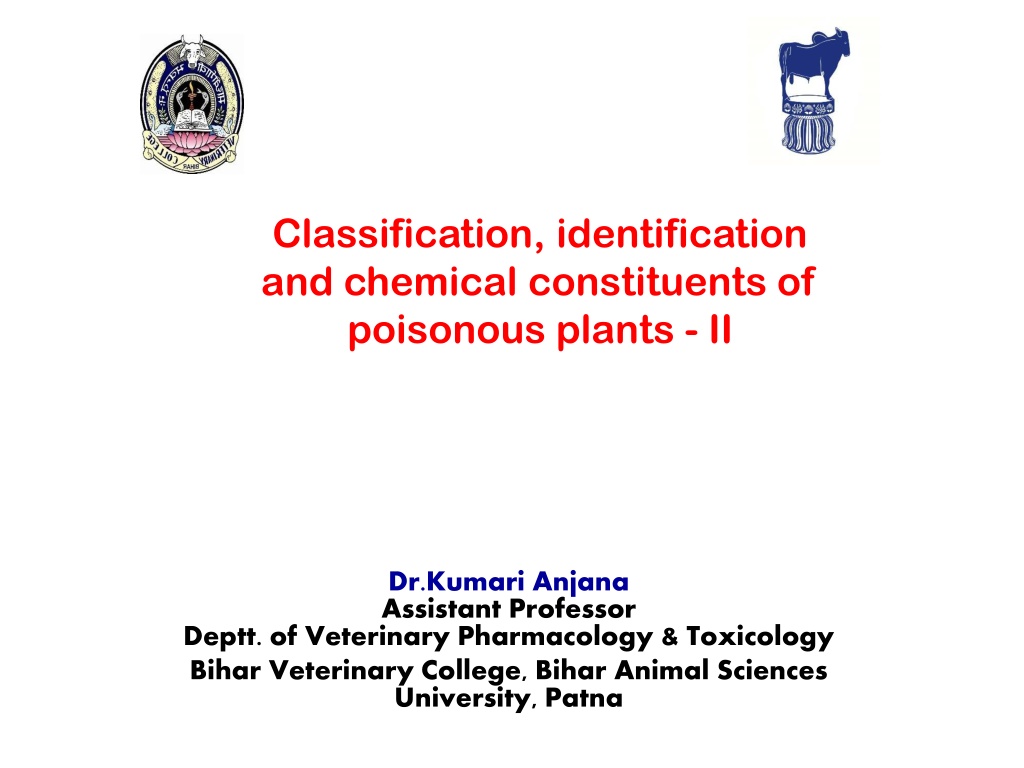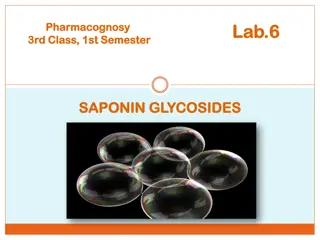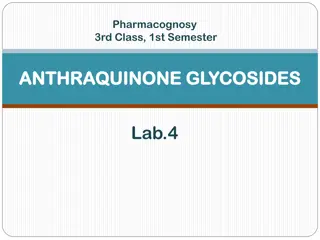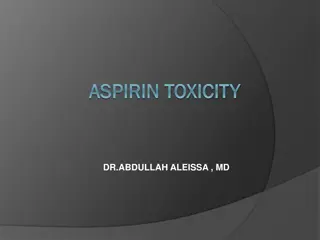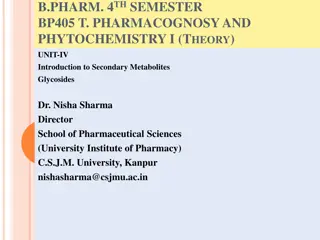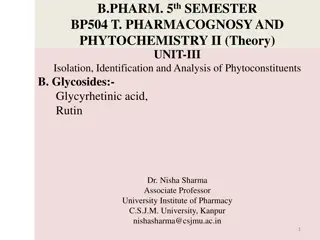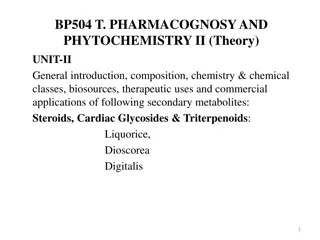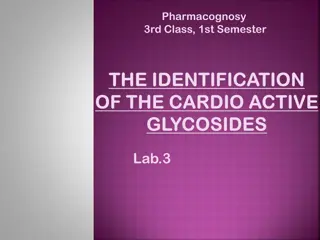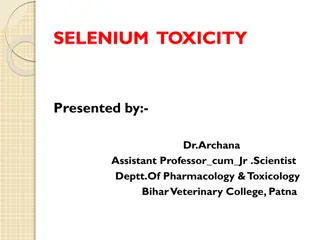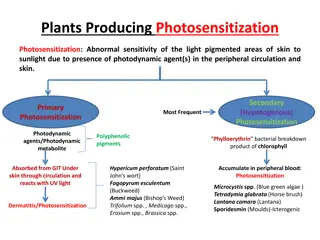Understanding Glycosides: Classification, Identification, and Toxicity in Poisonous Plants
Glycosides, ethers with a carbohydrate and non-carbohydrate moiety, are key toxicants in poisonous plants. Cyanogenic glycosides yield hydrocyanic acid, goitrogenic glycosides inhibit thyroid hormone production, while coumarin glycosides can lead to vitamin K deficiency. Steroid and triterpenoid glycosides, such as cardiac glycosides found in foxgloves, impact heart function. Each type has distinct chemical actions, making awareness crucial for veterinary professionals.
Download Presentation

Please find below an Image/Link to download the presentation.
The content on the website is provided AS IS for your information and personal use only. It may not be sold, licensed, or shared on other websites without obtaining consent from the author. Download presentation by click this link. If you encounter any issues during the download, it is possible that the publisher has removed the file from their server.
E N D
Presentation Transcript
Classification, identification and chemical constituents of poisonous plants - II Dr.Kumari Anjana Assistant Professor Deptt. of Veterinary Pharmacology & Toxicology Bihar Veterinary College, Bihar Animal Sciences University, Patna
2. Glycosides Glycosides are ethers containing a carbohydrate moiety and a non-carbohydrate moiety (aglycone) joined with an ether bond. They are usually bitter substances. Often the aglycone is released by enzymatic action when the plant tissue is damaged, as by wilting, freezing, mastication, or trampling. They are classified on the basis of the structure and/or properties of the aglycone.
Different kind of glycosides Cyanogenic Glycosides Goitrogenic Glycosides Coumarin Glycosides Steriod and Triterpenoid Glycosides Cardiac glycosides Saponins Nitropropanol Glycosides Vicine Calcinogenic Glycosides Carboxyatractyloside Isoflavones
Cyanogenic Glycosides These yield hydrocyanic (prussic) acid when hydrolyzed. An example is amygdalin found in the kernels of almonds, apricots, peaches, apples, and the leaves of choke-cherries. It is hydrolyzed by -glycosidase to release hydrogen cyanide, glucose, and benzaldehyde. The hydrogen cyanide is a potent inhibitor of cytochrome oxidase, a respiratory enzyme.
Goitrogenic Glycosides Goitrogens decrease production for the thyroid hormones by inhibiting their synthesis by the thyroid gland. As a result, the thyroid enlarges to compensate for reduced thyroxine. These thioglucosides) are commonly found in Brassica spp. such as cabbage, kale, and rape. compounds, called glucosinolates (formerly called They are hydrolyzed by glucosinolates to -D-glucose, HSO4-, and derivatives of the aglycone. These include isothiocyanates, nitriles, and thiocyanates. The glucosinolates are anions, usually found as potassium salts. The glucosinolase is released from plant tissue by crushing (mastication) and is also produced by rumen microorganisms. Isothiocyanates may form ring structures and as goitrin (5-vinyl-2- oxazolidine-thione).
Coumarin Glycosides Coumarin (Melilotus spp.) as melilotoside. is found in sweet clover Coumarin is converted by mold growth to dicoumarol, an antagonist of vitamin K. Sweet clover poisoning, caused by feeding mouldy sweet clover hay, is therefore an induced vitamin K deficiency.
Steriod and Triterpenoid Glycosides Cardiac glycosides The best known cardiac glycoside is digitoxin, contained in foxgloves (Digitalis spp.) as the name suggests, these glycosides contain a sterol group in their structure. Physiologically, they are potent stimulators of heart rate and are used medicinally. Milk weeds (Asclepias spp.) contain cardiac glycosides (cardenolides) and are extremely toxic to livestock. As little as 100g of milkweed can kill a sheep.
Saponins Saponins are glycosides which have profuse foaming properties, producing a distinctive honeycombed stable foam when a aqueous solution is shaken. They are widely distributed in plants and, in animal nutrition, are particularly important in temperate legume forages. They are bitter compounds, affecting palatability and feed intake. They have growth-depressing properties in poultry and swine, and have been implicated in boat in ruminants. Saponins contain a polycyclic aglycone (steroid or triterperoid) and a side chain of sugars attached by an ether bond to C3.
Nitropropanol Glycosides Many Astragalus species, such as timber milk vetch (Astragalus miser), owe their toxicity to this class of glycoside. They are metabolized to-- 3-nitro-1-propanol (3NPOH) in ruminants, and 3-nitropropionic acid in non-ruminants. These compounds, especially 3NPOH, are acutely toxic, producing methemoglobinemia. They also produce chronic toxicity permanent nerve damage. symptoms, involving This class of glycosides is also found in crown vetch (Coronilla spp.)
Vicine Vicine is a glycoside in fava beans (Vicia faba). It cause haemolytic anemia (favism) in people who have a genetic deficiency of glucose-6-phosphate dehydrogenase activity in their red blood cells. Fava beans are being utilized, especially in Canada, as a protein supplement for livestock.
Calcinogenic Glycosides Some plants, such as Cestrum diurnum, Solanum, Solanum malacoxylon, and Trisetum flavescens, have glycosides that contain the active metabolite of vitamin D (1,25-dihydroxycholecalciferol). The consumption of these plants by cattle and horses results in excessive levels of active vitamin D in their tissues, overriding the feedback control mechanisms involved in calcium homeostasis. This results in excessive calcium absorption and the calcification of soft tissues such as arteries and kidney.
Carboxyatractyloside A glycoside called carboxyatractyloside has been identified as the toxicant in cocklebur (Xanthium strumarium). It produces hepatic lesions, convulsions, and severe hypoglycaemia.
Isoflavones These phytoestrogens, contain a flavones nucleus. compounds, which are called Examples of isoflavones are genistein, and coumestrol. Isoflavones subterranean clover and have caused extensive reproductive problems in sheep in Australia. are particularly important in
3. Proteins Several important inhibitors in plants are proteins. Of interest is that in some cases the effect of these is to inhibit the utilization of other proteins by animals.
Protease (Trypsin) and Amylase Inibitors Soybeans, most other legume seeds, and some grains (e.g., rye and triticale) contain trypsin inhibitors. These are small protein molecules which combine with and inactivate the digestive enzyme trypsin in the small intestine. They cause reduced growth and pancreatic hypertrophy. Amylase inhibitors occur in beans and have been commercialized as starch blockers to reduce obesity in humans.
Lactins (Hemagglutinins) These are glycoproteins of 60,000- 100,000 MW that cause agglutination (clumping) of red blood cells in vitro. They are found in most types of beans, including soybeans. They cause reduced growth, diarrhea, and interfere with nutrient absorption.
Enzymes An example of an enzyme toxin is thiaminase, found in bracken fern (Pteridium aquilinum) and certain fish such as carp. The enzyme cleaves the B vitamin thiamine, thereby inactivating it. Consumption of bracken fern causes thiamine deficiency in some animals. Use of carp and other types of thiaminese- containing fish in mink diets has produced thiamine deficiency (Chastek s paralysis).
Plant Cytoplasmic proteins Many leguminous forages such as alfalfa and numerous clovers may cause boat in ruminants. This is primarily due to formation of a stable foam in the rumen, involving cytoplasmic proteins in the plant cell contents.
4. Amino Acids and Amino Acid Derivatives Amino Acids There are over 300 amino acids in plants. Not surprisingly, some of these are toxic. The best known is mimosine, which is structurally similar to tyrosine. Mimosine occurs in the tropical forage L. leucocephala, which produces protein-rich leaves that have considerable potential as livestock feed. Mimosine causes reduced growth and alopecia (loss of hair) in non-ruminants and is metabolized in the rumen to a goitrogenic compound, producing goiter in ruminants.
Tryptophan is a dietary essential amino acid. It can also be regarded as a toxicant because under some conditions it is metabolized in cattle to 3-methylindole, a compound responsible for acute bovine pulmonary emphysema. Dihydroxyphenylalanine (dopa) occurs in fava beans and has pharmacological effects. Selenoamino methylselenocysteine, selenomethionine, which contain selenium in place of sulphur, are implicated in selenium toxicity due to consumption of selenium accumulator plants such as Astragalus spp. acids, such selenocystethionine, as selenocystine, and
There are several lathyrogenic amino acids, including -cyano-L-alkanine in Vicia spp. and -amino propionitrile in Lathyrus spp. Lathyrus seeds are consumed as food in India, causing a major public health problem, as permanent paralysis and skeletal deformity may occur. In livestock, consumption of Lathyrus odoratus seeds by cattle and horses causes paralysis, aortic aneurysm, and skeletal deformity. Lathyrism is the term used to describe the symptoms; both neurolathyrism (paralysis) and deformity) are observed. osteolathyrism (skeletal Another toxic amino acid is 1-amino-D-proline. It is produced from linatine, found in linseed meal. 1-Amino-D-proline is an antagonist of pyridoxine (vitamin B6).
Indospecine is a toxic amino acid found in Indigofera spicata, a potentially useful tropical pasture legume. It is an antagonist of arginine, resulting in depressed incorporation of arginine into liver- synthesized proteins. The brassica anemia factor, S-methylcysteine sulfoxide, is an amino acid derivative. It leads to red blood cell hemolysis and anemia. It is found in forage brassicas such as kale and turnips.
Polypeptides Amanita mushrooms are extremely poisonous and owe their toxicity to cyclic polypeptides. An unusual livestock poisoning problem in Australia is caused by the larvae of the sawfly, which contain an octapeptide called lophyrotomin. The sawfly larvae congregate in mounds beneath the silver-leaf ironbark melanophloia) and are avidly consumed by cattle. tree (eucalyptus Affected animals show incoordination, trembling, and liver damage.
